#usda turn time
Explore tagged Tumblr posts
Text
average United States contains 1000s of pet tigers in backyards" factoid actualy [sic] just statistical error. average person has 0 tigers on property. Activist Georg, who lives the U.S. Capitol & makes up over 10,000 each day, has purposefully been spreading disinformation adn [sic] should not have been counted
I have a big mad today, folks. It's a really frustrating one, because years worth of work has been validated... but the reason for that fucking sucks.
For almost a decade, I've been trying to fact-check the claim that there "are 10,000 to 20,000 pet tigers/big cats in backyards in the United States." I talked to zoo, sanctuary, and private cat people; I looked at legislation, regulation, attack/death/escape incident rates; I read everything I could get my hands on. None of it made sense. None of it lined up. I couldn't find data supporting anything like the population of pet cats being alleged to exist. Some of you might remember the series I published on those findings from 2018 or so under the hashtag #CrouchingTigerHiddenData. I've continued to work on it in the six years since, including publishing a peer reviewed study that counted all the non-pet big cats in the US (because even though they're regulated, apparently nobody bothered to keep track of those either).
I spent years of my life obsessing over that statistic because it was being used to push for new federal legislation that, while well intentioned, contained language that would, and has, created real problems for ethical facilities that have big cats. I wrote a comprehensive - 35 page! - analysis of the issues with the then-current version of the Big Cat Public Safety Act in 2020. When the bill was first introduced to Congress in 2013, a lot of groups promoted it by fear mongering: there's so many pet tigers! they could be hidden around every corner! they could escape and attack you! they could come out of nowhere and eat your children!! Tiger King exposed the masses to the idea of "thousands of abused backyard big cats": as a result the messaging around the bill shifted to being welfare-focused, and the law passed in 2022.
The Big Cat Public Safety Act created a registry, and anyone who owned a private cat and wanted to keep it had to join. If they did, they could keep the animal until it passed, as long as they followed certain strictures (no getting more, no public contact, etc). Don’t register and get caught? Cat is seized and major punishment for you. Registering is therefore highly incentivized. That registry closed in June of 2023, and you can now get that registration data via a Freedom of Information Act request.
Guess how many pet big cats were registered in the whole country?
97.
Not tens of thousands. Not thousands. Not even triple digits. 97.
And that isn't even the right number! Ten USDA licensed facilities registered erroneously. That accounts for 55 of 97 animals. Which leaves us with 42 pet big cats, of all species, in the entire country.
Now, I know that not everyone may have registered. There's probably someone living deep in the woods somewhere with their illegal pet cougar, and there's been at least one random person in Texas arrested for trying to sell a cub since the law passed. But - and here's the big thing - even if there are ten times as many hidden cats than people who registered them - that's nowhere near ten thousand animals. Obviously, I had some questions.
Guess what? Turns out, this is because it was never real. That huge number never had data behind it, wasn't likely to be accurate, and the advocacy groups using that statistic to fearmonger and drive their agenda knew it... and didn't see a problem with that.
Allow me to introduce you to an article published last week.
This article is good. (Full disclose, I'm quoted in it). It's comprehensive and fairly written, and they did their due diligence reporting and fact-checking the piece. They talked to a lot of people on all sides of the story.
But thing that really gets me?
Multiple representatives from major advocacy organizations who worked on the Big Cat Publix Safety Act told the reporter that they knew the statistics they were quoting weren't real. And that they don't care. The end justifies the means, the good guys won over the bad guys, that's just how lobbying works after all. They're so blase about it, it makes my stomach hurt. Let me pull some excerpts from the quotes.
"Whatever the true number, nearly everyone in the debate acknowledges a disparity between the actual census and the figures cited by lawmakers. “The 20,000 number is not real,” said Bill Nimmo, founder of Tigers in America. (...) For his part, Nimmo at Tigers in America sees the exaggerated figure as part of the political process. Prior to the passage of the bill, he said, businesses that exhibited and bred big cats juiced the numbers, too. (...) “I’m not justifying the hyperbolic 20,000,” Nimmo said. “In the world of comparing hyperbole, the good guys won this one.”
"Michelle Sinnott, director and counsel for captive animal law enforcement at the PETA Foundation, emphasized that the law accomplished what it was set out to do. (...) Specific numbers are not what really matter, she said: “Whether there’s one big cat in a private home or whether there’s 10,000 big cats in a private home, the underlying problem of industry is still there.”"
I have no problem with a law ending the private ownership of big cats, and with ending cub petting practices. What I do have a problem with is that these organizations purposefully spread disinformation for years in order to push for it. By their own admission, they repeatedly and intentionally promoted false statistics within Congress. For a decade.
No wonder it never made sense. No wonder no matter where I looked, I couldn't figure out how any of these groups got those numbers, why there was never any data to back any of the claims up, why everything I learned seemed to actively contradict it. It was never real. These people decided the truth didn't matter. They knew they had no proof, couldn't verify their shocking numbers... and they decided that was fine, if it achieved the end they wanted.
So members of the public - probably like you, reading this - and legislators who care about big cats and want to see legislation exist to protect them? They got played, got fed false information through a TV show designed to tug at heartstrings, and it got a law through Congress that's causing real problems for ethical captive big cat management. The 20,000 pet cat number was too sexy - too much of a crisis - for anyone to want to look past it and check that the language of the law wouldn't mess things up up for good zoos and sanctuaries. Whoops! At least the "bad guys" lost, right? (The problems are covered somewhat in the article linked, and I'll go into more details in a future post. You can also read my analysis from 2020, linked up top.)
Now, I know. Something something something facts don't matter this much in our post-truth era, stop caring so much, that's just how politics work, etc. I’m sorry, but no. Absolutely not.
Laws that will impact the welfare of living animals must be crafted carefully, thoughtfully, and precisely in order to ensure they achieve their goals without accidental negative impacts. We have a duty of care to ensure that. And in this case, the law also impacts reservoir populations for critically endangered species! We can't get those back if we mess them up. So maybe, just maybe, if legislators hadn't been so focused on all those alleged pet cats, the bill could have been written narrowly and precisely.
But the minutiae of regulatory impacts aren't sexy, and tiger abuse and TV shows about terrible people are. We all got misled, and now we're here, and the animals in good facilities are already paying for it.
I don't have a conclusion. I'm just mad. The public deserves to know the truth about animal legislation they're voting for, and I hope we all call on our legislators in the future to be far more critical of the data they get fed.
#big cats#tiger king#my research#news#big cat public safety act#animal welfare#big cat welfare#legislation and regulation#vent post#long post#crouchingtigerhiddendata#more on the problems with the bill in the future
7K notes
·
View notes
Text
How long does it take to close a Kentucky Rural Housing Loan in Kentucky?
How long does it take to close a Kentucky Rural Housing Loan in Kentucky?

View On WordPress
#first time home buyer ky usda#Kentucky#Louisville Kentucky#Mortgage loan#turn times USDA loan#Underwriting Turn Times on Rural Housing USDA Loans in Kentucky#underwriting turn times USDA
0 notes
Text
Good news, folks. Two big things happened this last weekend. One, NASA proved that ghosts are real. Yeah, I don't know how it happened either, I bet they pointed one of their big satellites toward Earth instead of away from it and then whoop, ghosts. Two is that we figured out how to charge the ghosts rent. The economy's fixed!
That science is new, so new that the USDA won't let you eat it without cooking it to a safe internal temperature. We're still operating under a lot of theories about ghosts, and the prevailing one is that ghosts are people who have died but cannot leave this plane of existence until they resolve their unfinished business. And until they do that, every chain-rattle, spooky door-opening, and creaking noise your house makes is deliciously billable. It turns out that you were a landlord this entire time, just not a very business-savvy one.
Sure, there are already a lot of people crying it's "unethical" to force these ghosts, who cannot leave under any means whatsoever, to pay up. Most of them don't even have any money, ethereal or otherwise, except for the small amounts they scraped together to pay Charon "just in case." Thing is: either they pay the money, or They'll expect us to. And I have already spent all of my ghost bucks on a junkyard V8, which is the least I could do to take my mind off of a shrieking lady with no face constantly bothering me about where her family is.
When I finally pass on, probably in some kind of exploding-bellhousing accident, I'm sure that this won't come back to bite me in any way. Roaming the earth until I actually finish a project is basically how I spend my Saturdays already.
238 notes
·
View notes
Text
Millions of U.S. apples were almost left to rot. Now, they'll go to hungry families
NOVEMBER 27, 2023 By Alan Jinich
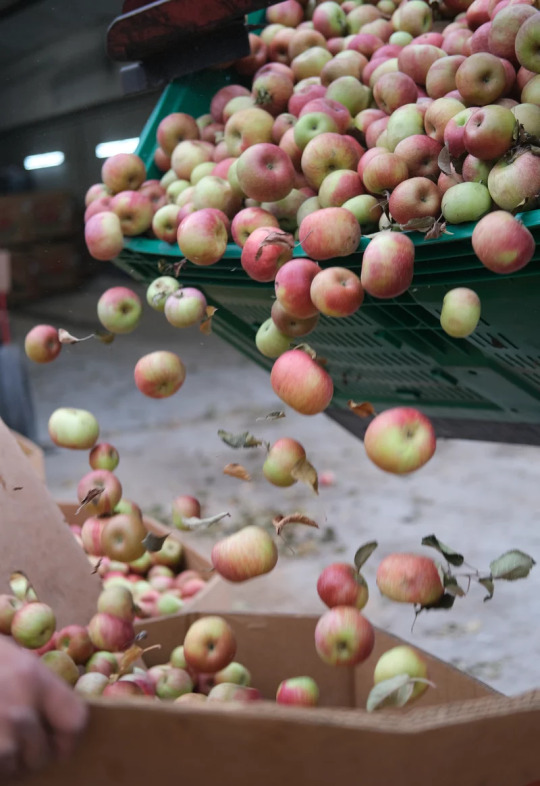
It's getting late in the harvest season in Berkeley County, West Virginia and Carla Kitchen's team is in the process of hand-picking nearly half a million pounds of apples. In a normal year, Kitchen would sell to processors like Andros that make applesauce, concentrate, and other products. But this year they turned her away. ... Across the country, growers were left without a market. Due to an oversupply carried over from last year's harvest, growers were faced with a game-time economic decision: Should they pay the labor to harvest, crossing their fingers for a buyer to come along, or simply leave the apples to rot?
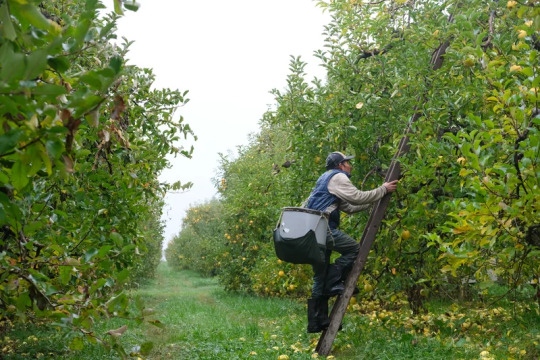
Bumper crops, export declines and the weather have contributed to the apple crisis
... While many growers in neighboring states like Maryland and Virginia left their apples to drop. Sen. Joe Manchin of West Virginia was able to convince the United States Department of Agriculture (USDA) to pay for the apples produced by growers in his state, which only makes up 1% of the national market.
A relief program in West Virginia donated its surplus apples to hunger-fighting charities
This apple relief program, covered under Section 32 of the Agricultural Adjustment Act of 1935, purchased $10 million worth of apples from a dozen West Virginia growers. Those apples were then donated to hunger-fighting charities across the country from South Carolina and Michigan all the way out to The Navajo Nation.
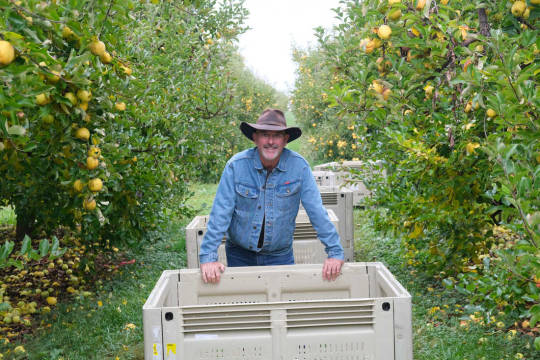
Mike Meyer, head of advocacy at The Farmlink Project, says it's the largest food rescue they've ever done and they hope it can serve as a model for their future missions. "There's over 100 billion pounds of produce waste in this country every year; we only need seven billion to drive food insecurity to zero," Meyer says. "We're very happy to have this opportunity. We get to support farmers, we get to fight hunger with an apple. It's one of the most nutritional items we can get into the hands of the food insecure."
At Timber Ridge Fruit Farm in Virginia, owners Cordell and Kim Watt watch a truck from The Farmlink Project load up on their apples before driving out to a food pantry in Bethesda, Md. Despite being headquartered in Virginia, Timber Ridge was able to participate in the apple rescue since they own orchards in West Virginia as well. Cordell is a third-generation grower here and he says they've never had to deal with a surplus this large.
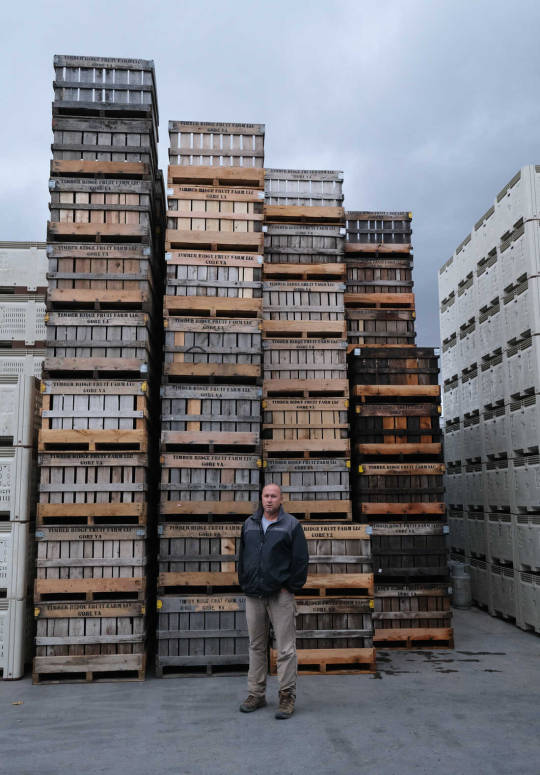
At the So What Else food pantry in Bethesda, Md., apple pallets from Timber Ridge fill the warehouse up to the ceiling. Emanuel Ibanez and other volunteers are picking through the crates, bagging fresh apples into family-sized loads. "I'm just bewildered," Ibanez says. "We have a warehouse full of apples and I can barely walk through it." "People in need got nutritious food out of this program. And that's the most important thing" Executive director Megan Joe says this is the largest shipment of produce they've ever distributed – 10 truckloads over the span of three weeks. The food pantry typically serves 6,000 families, but this shipment has reached a much wider circle. "My coworkers are like, 'Megan, do we really need this many?' And I'm like, yes!" Joe says. "The growing prices in the grocery stores are really tough for a lot of families. And it's honestly gotten worse since COVID."
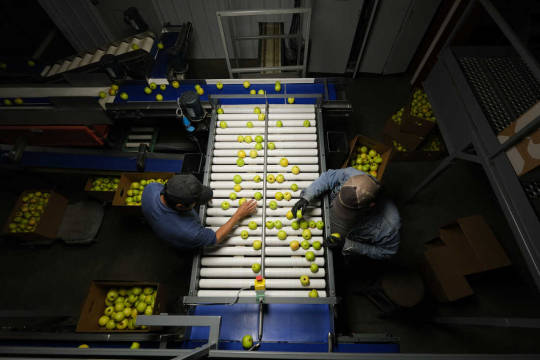
"It's the first time we've done this type of program, but we believe it can set the stage for the region," Kent Leonhardt, West Virginia's commissioner of agriculture says. "People in need got nutritious food out of this program. And that's the most important thing." Following West Virginia's rescue program, the USDA announced an additional $100 million purchase to relieve the apple surplus in other states around the country. This is the largest government buy of apples and apple products to date. But with the harvest window coming to an end, many growers have already left their apples to drop and rot.
192 notes
·
View notes
Text
@markeatsmeat
Wow. Joel Salatin, a farmer and regenerative agriculture advocate, has been offered a position within the USDA. He will advise Thomas Massie who’s agreed to be Secretary of Agriculture. Here’s the full message posted to his website today: “The deplorables and garbage people won again. Can you believe it? I've been contacted by the Trump transition team to hold some sort of position within the USDA and have accepted one of the six "Advisor to the Secretary" spots. My favorite congressman, Thomas Massie from Kentucky, has agreed to go in as Secretary of Agriculture. He's been the sponsor of the PRIME ACT, which, if pushed through, would be the biggest shot across the bow of the entrenched industrial meat processing system we've seen in a century. Let liberty ring. Wouldn't that be a change of fortune for Big Ag? If RFK Jr. goes in as Sec. of Health and Human Services, everything will be inverted. Talk about the coolest turn about. He'd be the boss of the Faucis and Francis Collins--the whole covid anti-science crowd. Wouldn't that be a change of fortune for Big Pharma? And if Elon Musk goes in as a Government Waste Czar, do you think he could possibly find something? Here's an interesting tidbit. All the income taxes in the U.S. are $2 trillion a year. Government spending and borrowing are so out of control that if we eliminated $2 trillion from the budget, it would only set us back to 2020. Does anyone think returning to government spending in 2020 would destroy things? Of course not. So all we have to do is cut federal spending to 2020 levels and we can eliminate income tax. Period. Done. How would that make you feel? Most people don't know enough history to know that the federal government was to be financed entirely from tariffs and excise taxes. In fact, as a nation we operated just fine for nearly 150 years without an income tax. The only president who eliminated the national debt was Andrew Jackson, and he did it by eliminating the second bank of the U.S. Nearly 100 years later we got the third bank, known as the Federal Reserve, plus the income tax. During that time, tariffs averaged 40-50 percent. After the income tax, tariffs dropped to an average of about 7 percent, where they remain today. If we went back to 40 percent, like we had for nearly 150 years, we would bring production home and free our citizens from impoverishing taxes. Dear folks, this is a watershed moment to take a creative and serious look at the sacred cows in our nation and fry some serious burgers. We don't know history. We don't know liberty. We don't know earthworms or aquifers or immune systems. I'm hoping this election is an opening to discovery. Perhaps we could even figure out how to put negative occurrences like jails, pollution, and cancer on the nation's balance sheet, as a liability rather than an asset (Gross Domestic Product--more jails? wonderful, pour more concrete and make more jobs). Perhaps we'll eliminate federal involvement in education, from kindergarten to college. Make every teacher accountable to performance. Eliminate ALL federal intervention in the food system, in farming, in energy. The Constitution (read it) doesn't allow for any of this and it's time to examine all of it. Shut down foreign military bases; bring them all home. Stop ALL foreign aid, from USAID to military aid. Sell stuff is fine; giving it isn't. I think whatever taxes we pay should be able to be designated to certain departments. That way we the people could support or defund departments directly. The reason we have K street is because all our freedoms are for sale. Eliminate government manipulation and the lobbyists all go home. These are simple things. Let's do it.” https://thelunaticfarmer.com/blog/11/6/2024/celebration?format=amp

28 notes
·
View notes
Text
Weekly Fic (and Meat!) Recs 70
Howdy everyone! Prepare yourselves for some fic recs, as well as a little bit of an info dump about meat science, curing edition!
I also got an ask this week for some Damian fics! Below is a link:
Damian Fic Recs The Coming of the Season by SalParadiseLost @salparadiselost - Batfam, wip. An omegaverse AU where the batkids are Bruce's biological children. Teenage mom Bruce my beloved.
Nature and Nurture by lurkinglurkerwholurks @lurkinglurkerwholurks - Batfam, complete. This fic was recommended to me by the anon who wanted some Damian fic recs. Anon, whoever you are, thank you for this fic rec, I thoroughly enjoyed it! Bruce gets hit with a deaged spell and his kids deal with Bruce as he ages up. Many new facts are learned and much feels are had.
You're moving to Metropolis? Is that even a real place? by Vamillepudding @vamillepudding - Batfam, complete. An AU where Bruce saves Jason before he dies in the warehouse and decides to leave Gotham and move to Metropolis. Tim has Opinions™ about this (so does Superman).
Where You Lead, I Will Follow by Batsymomma11 - Superbat, complete. A very pregnant Bruce has a bad time picking out what to wear for a gala. Luckily, his husband Clark is there to help :)
Freedom Of The Press by Ktkat9 @ktkat99 - Superbat, complete. Clark attends a Wayne gala event soon after his relationship with Bruce goes public on accident. Luckily, the bat kids are there to help him out.
IS IT JUST YOU AND ME IN THE WRECKAGE OF THE WORLD? by orpheusaki - Superfam, complete. Clark finds and rescues a young Conner from CADMUS and introduces him to the Justice League. Good dad Clark my b e l o v e d.
The One Where Bruce Is Under The Desk by Yippekia @yippekia - Superbat, complete. Lois barges into Clark's office at an inopportune time. Also, no one can find Bruce, who is supposed to be visiting the Daily Planet today :)))))))))))
Prism Fragments by mediant @blorb-el - Clark centric. A series of 100 word drabbles exploring Clark and the spectrum of kryptonite.
Continue on in the post if you are interested in learning about meat curing, otherwise, happy reading!
MEAT CURING 101
Or, everything you didn't want to know about meat curing :)
The first thing you have to know about meat curing is that it was a complete accident. Humans noticed that meat turned a bright pink color after it was smoked or certain ingredients were used in the smoking/drying/cooking process. The reason why it turned pink was because of natural nitrates found in smoke (that's what causes the pink smoke ring in BBQ meat), as well as sea salt and saltpeter. The awesome part about all of this, was that this accidental curing acted as an ancient antimicrobial that protected against C. botulinum (link to USDA FSIS food safety fact sheet), that nasty spore former that causes improperly canned foods to blow up like a balloon (also, if you find a can in your pantry that has blown up like a balloon, dO NOT CONSUME IT).
Why do humans continue to consume this cured meat. Well, it tastes pretty damn good. Go to any fast food restaurant and chances are there is a burger menu item with bacon. Or a breakfast item with ham. It just tastes GOOD. It also has that pretty pink color that stays with the meat after you cook it compared to the brown color you get when you cook uncured items. Moving away from the food quality aspects, it also helps extend shelf life of a meat product AND you have the food safety part I mentioned above. Not only does it protect against C. botulinum, but C. perfingens and L. monocytongenes as well.
How does this magical substance work??? Well, it's not magic, it's science! The protein responsible for meat color is called myoglobin.

In the middle of myoglobin, is an iron atom. What the redox state of the atom and what attaches to it affects the shape of the myoglobin, and this alters the color you see when you look at meat. So when it's just myoglobin hanging out by itself, a water molecule is attached to it and it appears purple. When oxygen attaches to the iron atom, it appears red. When the iron atom goes from a ferrous to a ferric state (basically, what happens when metal rusts), the meat appears brown. You can actually see this when you are out grocery shopping! If you see a piece of meat in a vacuum sealed bag, it appears purple. If the meat is in an over wrap tray, or in a display in a butcher counter, it looks red. When you see meat that has the discount sticker on it, it's starting to turn brown and needs to be consumed or frozen soon (That's why it was discounted. The meat is still safe to consume as long as you cook it properly and eaten that or the next day).
When you add nitrite to the mix, that's how you get the pink color change! The ancient curing methods used nitrate, but that needs to be reduced down to nitrite by a fermentation or a cure accelerator. Modern curing just uses nitrite, most commonly sodium nitrite. The sodium nitrite gets reduced to nitric oxide (this can be accelerated by adding ascorbate or erythorbate) and that binds with the meat to make nitrosomyoglobin. As the meat cooks, this creates nitrosohemochrome, which gives you the pink color!
In the US, most meat products are allowed 150ppm (parts per million, or 0.015%) according to the meat block weight. For bacon, it's a little lower at 120ppm (0.012%). Cure is very regulated in the US as well, because too much can harm humans. I remember when I was working as a quality assurance tech at a ready-to-eat (RTE) facility, I would have to weigh all the cure that production would use for the day. The weights and lot numbers of the cure would be recorded and tracked to make sure that the correct amount was used every day/night (depending on the shift). The storage was regulated as well. It could not be store above any other ingredient (so it wouldn't cause contamination if a bag opened), and it was locked up as well.
Like I mentioned earlier, modern curing used sodium nitrite (you might also see it called Sure Cure). It's normally white, but is dyed pink so it's not confused with other ingredients, like salt or sugar. Sure cure contains 6.25% nitrite, with the rest being salt. There are "natural" ingredients that can be used to cure meat, with the most common being celery powder. Cherry powder is also used as "natural" replacement for ascorbate, the accelerator mentioned above. Next time in the grocery store, check out the naturally cured bacon or ham. If the meat is pink, but the package says it is uncured, look on the back at the ingredient statement. Most likely, that product is using celery powder as its source of nitrite. The package might also say something about "no nitrites/nitrates added!". There will most likely be an asterisk next to that statement. Follow that asterisk to the bottom of the package to its partner asterisk. The statement there will probably says something along the lines to "except for nitrites/nitrates naturally found in celery powder and sea salt."
Welp, that is a very brief info dump about meat curing and why it's used in the meat industry. If you have any questions about it, let me know! I would be happy to answer them :)
#weekly fic recs#fic rec#fic recs#fanfic recs#fanfiction recommendations#fanfiction rec list#superbat#batman#bruce wayne#batfam#superman#clark kent#meat science#meat curing#curing meat#nitrates#nitrites
31 notes
·
View notes
Text
market update // september 28th 2024
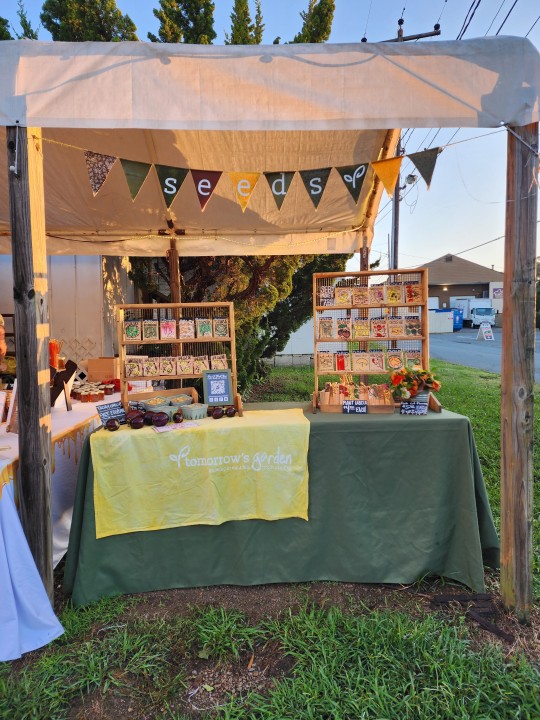
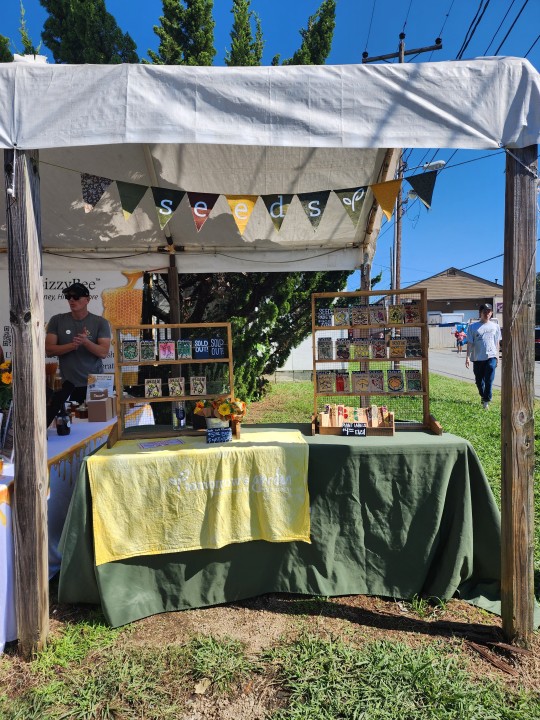
before market 👉 after market
another slow day. this time was because a lot of regular customers did come by to say hi, but that they were out of power after 2r hours from the hurricane so they were honest and said they just were there to get out of the house and not buying. when 3 different customers say that... then you know that's probably multiplied by at least 3. a lot of window shoppers overall at the market, not just me. about half the farmers didn't show up either because of storm damage. me myself and my hubs kitties and house are completely fine, but it was significantly worse south and west of us. and guess where most of the farmers are located 🫠
if there is ever any severe damage of any natural causes, they need your support then more than ever. they always need your support... but only the cash crop farmers are eligible for compensation loss from the USDA. the farmers at your local market are not eligible. support them.
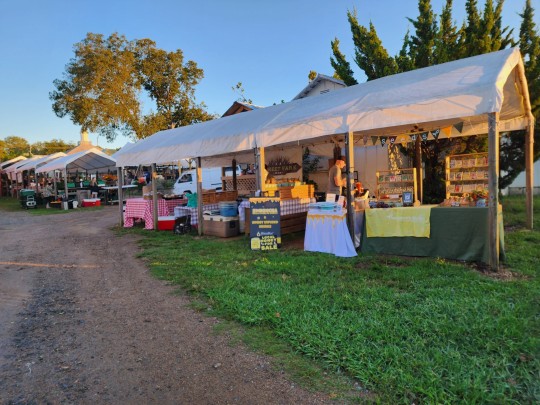
look at me, right at the very end. all my neighbors still setting up. the main market is right around the corner to the right. this is considered the back entrance so there is still traffic, but nowhere near as much as the main entrance.
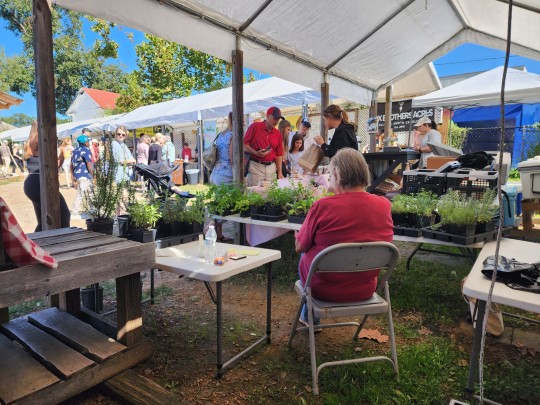

my sun tarp that kept attacking me when it was windy the other week didn't make it through the storm, so i spent about half the market taking refuge in the shade. i hung out with another plant vendor for a bit. i was telling her about my perennial flower garden, and i did already get spanish lavender from her. going to get more next time she's at market. she said spanish lavender is the easiest to grow - especially in these parts - but the flower heads don't look like the stereotypical lavender flower so a lot of people don't want it. i don't care, i want the bees to care! but she's wonderful, sells only herb transplants. she recommended a few more flower perennials for me... i forgot ehat they were but she said she got them so that's why i didn't bother remembering because i said SOLD and i'll get them from her later 😅 i'll tell y'all what they are when i get them.
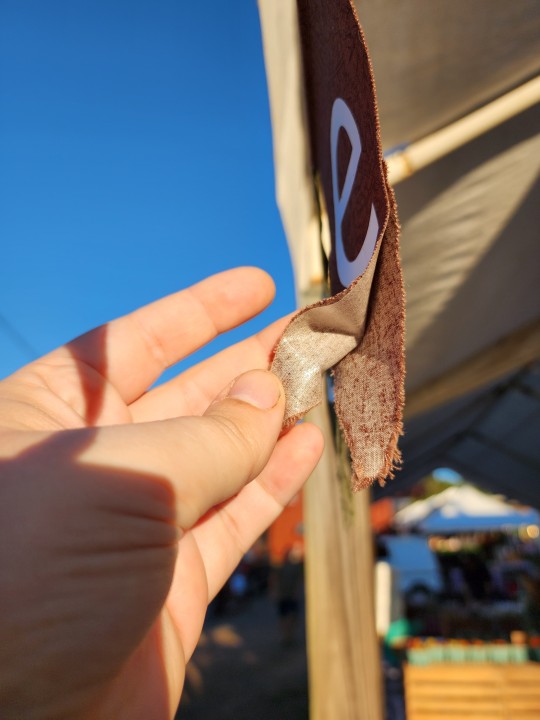
my sun tarp didn't make it, but my seed banner only got slightly frayed! easily fixable, fix it later.

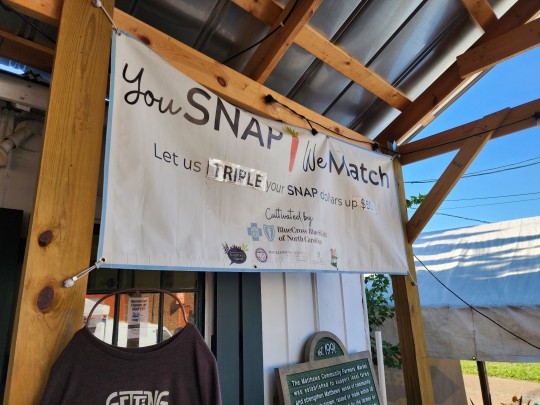
question of the day!! this applies to everyone, but this farmers market offers a special deal. if you have SNAPs, or food stamps...
seeds are covered by SNAPs!!
now, home depot or other large hardware stores won't accept SNAP cards because they don't sell food as their main source of income (well, customers aren't their main source of income but that's another post for another day). Those stores won't invest in accepting SNAPs to a "small" customer base. BUT!! Walmart, Target... other stores where they have groceries and a few seeds in the spring will accept SNAPs for vegetable and herb seeds. if it turns into something edible, it is covered by SNAPs:
✨️ the more you know ✨️ a couple of customers were surprised and got a lot of seeds after they learned that. me, personally, my goal is to eventually accept SNAPs on my website for selling seeds. it costs a lot of money to do so....... but it is still a high priority. for now, I can accept farmers' market tokens for the seeds.
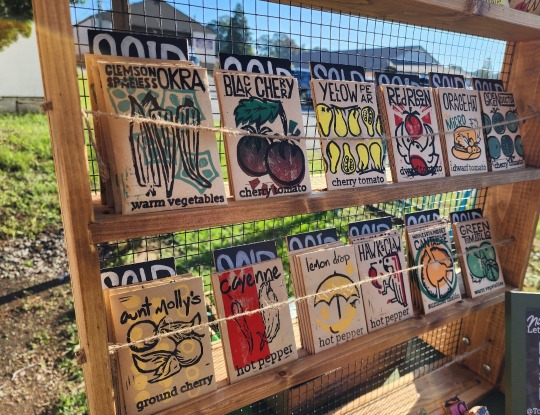
close up of seeds. seeds. seed seed seed seeds. appreciate the seeds.
kid wave back count: 1 out of 1. not too many kids today, surprisingly, but the one i waved at waved back. 100% wave back rate, let's gooooo.
#food not lawns#gardening#home garden#homegrown#food#gardenblr#grow food#suburban agriculture#suburban farm#farmer's market#farmers market#home farm#suburbia farming#farming#suburbian agriculture#farmcore
20 notes
·
View notes
Text
Excerpt from this story from The Revelator:
Researchers in Indonesia recently captured a surprising event on video: A wild orangutan named Rakus, with a deep gash on his cheek, harvested liana leaves, chewed them up, and rubbed them on his wound. His cheek healed without infection. As it turns out the plants have anti-inflammatory, antibacterial, antifungal, and other chemical properties that help heal wounds.
The great ape saw the plant, recognized the plant, and valued the plant because he knew something about a subject that few humans do anymore: botany.
At a time when our net knowledge about plants keeps growing, our individual understanding of plants is in decline. This is unsurprising, because while we still depend on plants for life, few of us need to know much about them in our daily lives — as long as someone else does. We rely on botanists to identify plants, keep them alive, and in so doing help keep us alive as well.
It’s a lot of responsibility for a group of scientists that isn’t getting any bigger. And that has some people in the field worried.
The National Center for Education Statistics triggered the first alarm about the future of botany in 2015. According to data released that year, the number of annual undergraduate, graduate, and doctoral degrees awarded in botany or plant biology in the United States had dropped below 400 for the fifth time since 2007. In 1988 the number of degrees was 545.
The number soon rose again and so far has stayed above 400. In fact it rose to 489 in 2023 — the highest in decades. (By comparison, American universities gave out more than 45,000 marketing degrees last year.)
The definitive downward trend, though, remains in the number of U.S. institutions offering botany or plant biology degrees — from 76 in 2002 to 59 in 2023.
“Botany Ph.D.’s are disappearing,” says Kathryn Parsley, who got her Ph.D. in biology, not botany, even though her dissertation focused on plants. “The number of botanists is declining rapidly and the people filling those spaces are not botanists.” When a biology department has a job vacancy, she says, they tend to hire a professor who has “nothing to do with plants. The department will have all kinds of scientists in it, with only one or maybe two botanists, sometimes only one or two plant scientists at all.” Because she attended one such school, “a botany degree was out of the question,” Parsley says.
While nobody has tracked the average age of botanists in the United States, students of “pure botany” do seem to be waning, according to Kristine Callis-Duehl, the executive director of education research and outreach at the Donald Danforth Plant Science Center in St. Louis. “Skills are shifting away from old-school botany. A lot of that’s being driven by funding sources,” she says. “More and more, just being a botanist is not enough in academia.”
Experts agree that in recent years, most botany professors aren’t being replaced once they retire. But why?
Money is one reason. The National Science Foundation, for instance, has shifted its funding away from natural history at herbariums and other museums, Callis-Duehl says. “It’s harder to convince Congress that that work — pure botany — contributes to the economy. They prefer basic science that can lead into more applied science, where they can make a case that it fuels the U.S. economy.”
Applied plant science has more NSF options than botany. For example, agriculture is more likely to be funded by USDA, Callis-Duehl says.
14 notes
·
View notes
Text
Character Profile - America

Character Name: USA, Murica, Alfred, Alfie-come-lately, Al. 1585-1775 - Alfred F Kirkland. 1775-???? - Alfred F Jones.
Age: 16 as of 1775, 18 in 1789, 21 mid 19th century. 25 by WW2 and still generally in that range.
Height: 6'0/183cm in 1775, 6'2/189cm after 1850ish.
Physical Description: This child was born a tungsten cube and grew into an adamantium adult. He's tall, broad-shouldered and strong. USDA Grade-A corn-fed BEEF right here. He's muscle as fuck with a good inch of fat on him every which way. Really putting the dough in doughboy. He's athletic, with the shoulders of a linebacker but is shockingly graceful and easy in his body. Arthur loved him enough that the confidence and good nature he exuded in his posture and looks are 100% genuine 80% of the time. He was an absolute cherub of a baby and grew into the kind of good looking that would really be described as more beautiful than handsome if he wasn't as broad as the baptist definition of sin.
Eye colour: Pacific, deep water navy, NASA mission blue. Dark, dark blue. Almost black, if not in good light.
Hair colour/style: Amber waves of grain. Two or three shades darker than Matt's and less red than Matt's or Jack's. Imagine all the wheatfields of America at the reaping, find the average tone, and that's Alfred's hair colour. Rich, harvest grain gold. It has a good amount of wave to it that shows even with its being short. He's generally worn it short and to one side to show off the wave he can get. Had some wicked curtain bangs in the 90s tho.
Other distinguishing physical traits: He has never worn a beard in his life, but it tends to come in redder than his hair. Aunt Bridgie's genes really start flexing there. He's got a mostly faded scar over his heart from Matt's pyromaniac-ass burning down DC. And probably more I'll have to add here later.
Personal Appearance/Style: Alfred loves looking good. The first thing Francis taught him was how good he could look and he's been following it ever since. He prefers blue suits, but he'll wear warm greys and black. He knows he looks like a ten-course meal in just grey joggers and a NASA t-shirt against those golden guns of his though. Also, the uniforms he picks are the ones that look good on him. Does he look like shit in one shade of olive drab? He's swapping it out. He showed up in Japan on the Black Ships in the most flattering cut of the Navy officer's uniform there was and it looked fucking good on him, all that dark blue with gold accents. He likes brown leather over black because the warmer colour looks better with his golden boy looks, and he knows it.
Verbal Style: He uses a neutral American or a less broad New England accent when overseas but slides in and out of any possible American accent at home. He got shot at during the Civil War because even in blue the whole goddamn time, he would slide into his original Virginia accent and have to duck rifle fire. Fucker probably sounded slightly transatlantic for a while in the 20th century. He doesn't purposefully code-switch from culture to culture; it's just automatic. He speaks several languages fluently and without an accent if he wants to, but he uses a southern accent speaking Japanese or a Kennedy Accent when speaking German. He knows it's not a jelly doughnut, Deutschland, promise! The more Arthur annoys him, the thicker his American accent gets.
Level of Education: Arthur educated him at home, got him, tutors on literally anything that Alfred fancied, apprenticed him out to any trade that interested him; printing and gunsmithing were the big ones, and then sent him to Harvard when he got bored with that. He graduated from West Point just before the Civil War and personally shot a few of his classmates who sided with the south :) but turned more to engineering, commerce and math after the war. He didn't reappear in the east until the 1880s, so he did a lot of mail-order books and self-study during that period. He also got another degree from The University of the Pacific in that period out west.
Occupation: The government is always trying to rope him into shit, but the boy's heart is in the stars, and something the government did has to be a big deal before he gives a flying fuck. His main squeeze is NASA, but he occasionally shows up to DC to steamroll some favours out of congress, especially when he has the urge to fly something experimental or a particular issue has been bothering him.
Past Occupations: Soldier, sailor, airman, astronaut, gunsmith, printing press operator, mechanical engineer, heiress, physicist, chemist, biologist, anthropologist, archaeologist, mechanic, railroad engineer, cowboy, blacksmith, cook, construction worker, gamekeeper, welder, a gold miner. The boy has some restlessness, okay? He's had many jobs.
Skills, Abilities or Talents: Alfred, even amongst nations, is quite freaky. Super strength, damage resistance, resurrection power that's faster than almost anyone. He can fly, drive, handle or otherwise operate any vehicle without training. He knows how they all work. He's also highly gifted in math and physics. He has been known to make California tremble a wee bit when he's genuinely well and fucking pissed. He'll get his ass lost on a boat or on foot, but in the air, he's possibly the best navigator on the face of the earth. But literally, he can do almost anything he sets his mind to. It's unnatural.
Admirable Personality Traits: Optimistic, idealistic, brilliant, generous, confident, fair.
Negative Personality Traits: Self-righteousness, recklessness, thoughtlessness, arrogance,
Sense of Humor: Silly, slapstick, observational.
Physical/Mental illness or affliction: He's sometimes just shy of narcissistic but usually pulls himself off the brim. Arthur's sons might be eligible for an ADHD diagnosis, but I did that on accident before I got diagnosed rifp. He's not the anxious or depressed type. He has had periods of pretty acute PTSD.
Hobbies/Interests: Computers and tech, filmmaking, archaeology, camping, hiking, adventure sports, surfing, paleontology, working out, protein foot products, star gazing, listening to audiobooks and podcasts. But, like, literally everything interests this kid.
Favourite Foods: BBQ; he can't pick a favourite style tho. Burgers, cheese fries, pizza, strangely flavoured novelty chips. Apple pie with ice cream and blueberry maple ice cream is his and Matt's favourite. Paw-paws are a very rare treat. Huckleberry-flavoured anything will make him absolutely grin.
Most important personal item: He expected to inherit Arthur's pocket watch like other sons did their fathers in the 18th century, so in 1976, when Arthur did give him the pocket watch and a very expensive wristwatch because the pocket watches had gone out of style, he has worn it everywhere since. To Mars and the Mojave, he'll wear that thing everywhere and get it repaired if it takes any damage.
Person/friend close to character: Matt's his best friend. He and Maria are also close but belligerent. Arthur is also in his top 5. Kiku, Ludwig, Tolys, Romano, Mai, etc, are all on his very close friend list. Of older nations, he and Brighid are very close, if complex.
Brief family history: He was born in 1585 or so in Virginia. Arthur said, "finders keepers," From that moment, he was the man's firstborn child. In his childhood, he mainly had Arthur and Rhys, and Alasdair and Brighid, somewhat less until later. He's never met his grandmother or her ghost. He was an only child for about 20-30 years and spent a lot of his childhood functionally an only child with Matt in Francois' care. The two youngest 'siblings' he's got he's not quite sure what to do with them. The relationship isn't precisely sibling-like, but he's pretty fond of them, and he has some trauma from being ditched in New England during the British Civil War, so he saved their asses in 1941.
Most painful experiences in the character’s past: I don't think anything can top the Civil War because he represented the Union, i.e. the United States. It took him years and years to recover, especially because he was living a rough out west lot of the post-war. He got consumption while personally marching to the sea to burn the fucking shit out of the Confederacy. :)
Their Song: Babylon by Barnes Courtney.
#Character Sheets || bodies and flesh of borders and fences#Alfred || o beautiful for spacious skies#hws america
164 notes
·
View notes
Text
To continue the theme of "wtaf is up with that sanctuary that feeds bears Twizzlers and camels Mountain Dew", here's another recent social media post I find rather concerning. Who the heck is giving cheetah - vulnerable animals with a very small population - to a sanctuary that is rabidly, openly anti-zoo and anti-conservation breeding?

The reason this stands out to me so much is that there just like... are not cheetah in sanctuaries in the US. Most cheetah in the US are part of a breeding program, either AZA's SSP or ZAA's AMP - it's not common to find them in even unaccredited zoos, much less newly moved to sanctuaries. Of the 400-some cheetah I found doing the big cat census in 2020, there were less than 10 in facilities that branded themselves as sanctuaries. So where did these cats come from?
What's more, okay, there's no trace of these ladies on social media before now. The Wild Animal Sanctuary is normally very open about their acquisitions, and no facility they've gotten animals from since their last USDA inspection has had cheetah. I haven't heard about any imported cheetah recently either, which is another thing you can check for this facility, because the majority of their rescues are imported from all over the world.
There's another weird thing about this post, too. Look at the language. It's all very "here's a cheetah! they're very happy outdoors in their nice habitat." And if you're not facility with this institution and their messaging, you might not catch why that's odd. This facility emphasizes, in every post they can, that their animals are rescued from horrible no-good very-bad abusive situations. Normally they name and shame if they can, or talk about how they came from the cub petting industry or private exploitation or such. There's none of that in this post, and it stands out because of it - especially because it's the first time these very rare, very charismatic big cats are being shared with their audience.
So where the heck did these cats come from?
Whelp.
Turns out the answer is AZA-accredited zoos. And whew, man, does that raise some questions.
Luckily these girls have some pretty distinctive names, so I was able to find them in the international and regional cheetah studbooks pretty easily. For both cats, the most recent listing in the studbooks was at AZA-accredited zoos in Texas: in 2020 Dahlila was living at Caldwell Zoo, and in 2022 Jaina was at Fossil Rim Wildlife Center.
Now, we don't know for sure that Caldwell and Fossil Rim are the facilities that chose to dump their cheetah in a sanctuary. There's some important context to know about exotic animal ownership and how animals leave AZA SSPs. General practice is that large charismatic mammals aren't bought and sold at AZA zoos, especially SSP animals, so animals sent out to other facilities for breeding or exhibition are moved around on loan. Sometimes their ownership changes with the transfer, but not always - it really depends on the species and how much control each facility wants to have over their animals. On top of that, the ownership of offspring sometimes alternates by litter or individual between the institutions that own the parents. When they're part of a cooperative breeding program none of that matters very much because all the animals are managed as a single population and moved as required for breeding and to fill empty display spaces. Where it's relevant is when an animal is removed from the SSP population - at that point it's totally up to the facility that owns it to choose where they live, as long as they send them somewhere AZA agrees is providing a reasonable standard of care. (This will be important in a little bit.)
So what we can tell from this situation is that Jaina and Dahlila were, for some reason, probably excessioned from the SSP in the last couple years. And whichever AZA facilities owned them decided to send them to The Wild Animal Sanctuary instead of finding a display-only placement at a zoo or safari park or similar facility.
Since I started writing this post, TWAS confirmed the origin of these girls in a Facebook comment.

I have real concerns about what appears to be an emerging trend of exotic animal exhibition facilities using sanctuaries as a "dumping ground" for their elderly or extra animals, in order to prioritize space for breeding or more desirable animals. I can't prove it yet, but there's been just enough weird transfers to have caught my attention. (In some cases, there's a good reason - sometimes all the habitats designed for the physical needs of elderly animals of a certain species already are full, and it's better for them to go somewhere they can exist more easily rather than trying to retrofit their current habitat - but it isn't every case). And here's the thing: many sanctuaries, like TWAS, message about how they have to exist to take all the discards from the zoo industry. In recent years that hasn't really been accurate, and historically, it did happen but not as commonly as it's portrayed. So... if that's true... and it's a bad thing... why are sanctuaries encouraging it by taking the animals zoos are transferring out to free up space? You'd think they'd want to say "find space in your own institutions and only call us if there's a crisis." (Money. The answer is money. Every new intake is used for marketing and drives additional donations.) Heck, why are zoos playing into that narrative, when they're frequently rebutting attacks claiming they discard the animals that aren't useful or aesthetic anymore?
All of this actually makes a lot of sense given how short on space all the AZA SSP programs are. Both in general, and for big cats, there are not enough spaces across accredited zoos to hold all the animals needed for sustainable populations. (This is why AZA just recently re-imagined their SSP programs, which is a whole other complicated mess that I am working on a writeup about). Recent political shifts within AZA corporate leadership have also discouraged collaborations between AZA-accredited zoos and non-AZA facilities, so while 20 years ago it would have been fine to move extraneous / non-breeding cats to smaller unaccredited facilities for display, that's less of an option. Which leaves sanctuaries as kind of the only politically appropriate option. This would also explain why the text of the post is so weird: there's probably a contract in place to prevent using their images to bash zoos.
The problem with sanctuaries as a solution for housing extra animals is, well, the quality of care they provide. If you haven't seen me say it before: sanctuaries are as varied in their expertise and function as zoos. In the case of The Wild Animal Sanctuary (and their other facilities, like the Refuge these cheetah are at) everything I have learned about them indicates that their animal care is highly questionable. Which is a problem, because - as mentioned earlier - AZA-accredited facilities are required to follow a responsible population management policy, which means ensuring that animals they send outside of AZA go somewhere that gives them high-quality care.

TWAS is an organization that prefers to feed big cats at multiple facilities frozen meat puree "frisbees" by chucking them over the fence. They don't have any way to separate co-housed cats to prevent conflict during feeding or resource guarding, because they don't build their enclosures with any sort of shift or lock-out areas. It's also unclear how they remove food waste without a way to shift animals out to go find it. (For bears they drive in on a truck into the habitat and then go on foot to clean, but I don't know if that's done with the big cats once they’ve been released from quarantine pens.
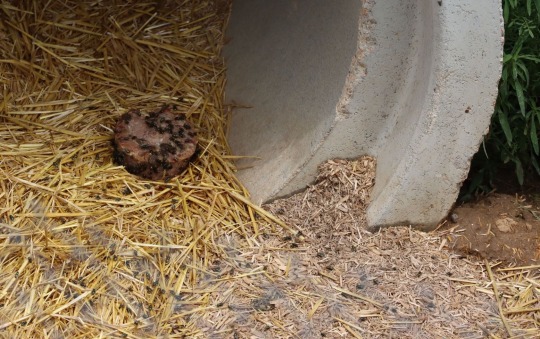
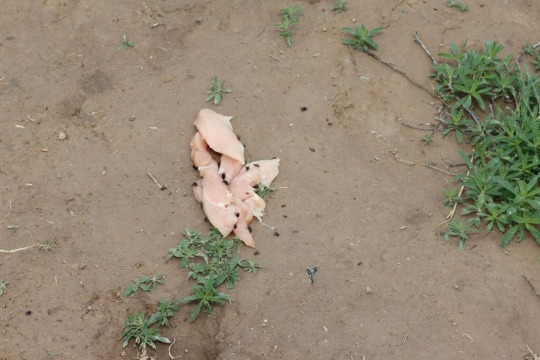
(These are my photos of food in carnivore habitats at TWAS this summer. Given the pest accumulation on the meat frisbee and the fact that I visited early in the day, it seems probable it was at least a day old.)
This is an organization that is ethically against training their animals for any reason: it's literally written into their statement of purpose as a “true sanctuary.” It's also described below, in a recent book published about the facility.
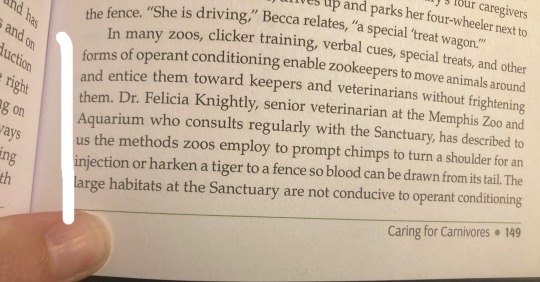
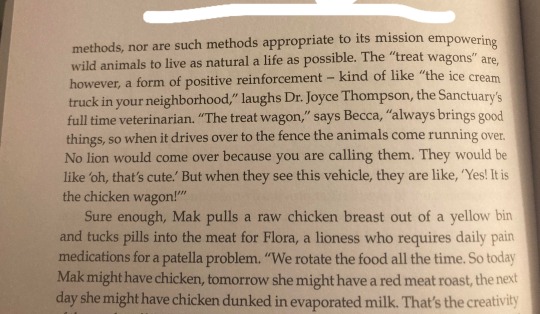
That policy means these cheetahs will not have a recall behavior, will not be trained for medical examinations or as a way to lower stress for procedures, and will not get the mental enrichment and interaction they're used to from regular training sessions. According to the book, medications are delivered on a long spoon / tongs tucked inside the cat equivalent of a pill pocket. (Which anyone with a pet cat knows falls apart as a plan if they're sick enough to not feel hungry).
I'm pretty sure there's no heated shelter for the large carnivores or bears at TWAS. The main shelter for animals at the Sanctuary is single-entrance concrete culverts buried underground far enough they're supposed to maintain a constant temperature all winter.

Sounds nice in theory, but with no second exit animals can get trapped down there, and there's no way to monitor them when they're inside. I don't know what type of shelter the Refuge provides, but it probably isn't much different. Even the quarantine spaces - smaller outdoor kennel-type pens with three exposed mesh panel walls - have no heat, and just an above-ground culvert block for them to curl up in. While cheetah are surprisingly adaptable to cold weather, winters in Colorado can be very harsh for prolonged periods of time.
As far as I know, most of the animals at facilities TWAS runs don't get regularly changed, novel enrichment. I've certainly never seen much in the habitats other than climbing structures when I've visited their main facility over the years, and most of their messaging around “toys” is semi-permanent furniture like giant telephone wire spools or a suspension bridge for climbing. I think some of the bears get balls? The messaging from TWAS is that their animal care is better because it's close to a natural life in the wild. Animals can be animals! When returned to their wild roots, animals shouldn't need anything from humans and are happier that way, etc.
When animals come to the Sanctuary (or the partner facility, the Refuge) they're literally chucked into a big fenced-off piece of land and left out there to "be cats" without human interaction except for feeding time and observations. Which is the polar opposite of what these cheetah are used to! AZA cheetahs, even those that aren't program animals, are intensely managed. They're used to regular human contact, frequent training, and constant enrichment. So what's "normal" for a wild cat is a far cry from what these cheetah girls have always known. That's not better - that's a loss of quality of life.
I don't understand how moving animals to places like TWAS is in line with AZA's Responsible Collection Management policy. I don't understand how AZA facilities think the type of husbandry the facility describes providing is acceptable. If another zoo utilized half the same care practices, they'd be drawn and quartered by their industry peers as well as by the public - and rightfully so. I don't understand why anyone wants to send animals there, based even just on what's easily observable. I don't have more information or really a conclusion, just that’s what's observable from an external vantage point is upsetting as heck and I worry for those cheetah girls.
#big cats#cheetahs#animal welfare#sanctuary politics#zoo industry politics#animal care#AZA#long post#this originally said cheetah are highly endangered which was a fact checking error#updated it to reflect that#bug tw
1K notes
·
View notes
Text
Well, alrighty then…
I’m still working on getting paid for April, it’s now June.
My one (and only) client’s stock soared by 20% on Friday because of a scathing open letter to the Board of Directors. All about how the CEO has bumble-fucked the company in the last 3 years. Basically blowing about $4B of investor capital in shitty decisions about online gaming and sports betting.
[you can Google it and read all about it if you want…the company is Penn Entertainment]
So my guess is come Tuesday at the AGM meeting, there’s going to be a massive shake up. Ironically Tuesday/ Wednesday is when I should be getting the notice to proceed on the San Antonio project.
Either the CEO is going to get fired, or many top level executives are getting fired, or at some point the company is going to be on the chopping block for sale. All because they took a shit on Barstool Sports. Then once they got done cleaning their pants, they shit them again with ESPN Bet.
Maybe, just maybe…hopefully, fingers crossed…they realize they need to focus on their brick and mortar locations. Plus perhaps, realize that many of their properties are failing due to poor maintenance, or life span of the building, and its components.
So come mid-June when yours truly turns the ripe old age of 51, maybe I can become so stupid crazy busy with too much work. Or, I’ll be floundering around and scrambling to figure out my next steps, because my livelihood has dried up.
————
In other news:
I found this wonderful gem of USDA organic gin from wheat made in Idaho last night. No comment about how most of it is gone.

Plus I dragged a brand new razor blade across my face, chin, jaw, and neck today. It’s been 7 or 8 weeks since I last did. So, for the time being I’m clean shaven. Give it about 3-1/2 to 4 hours and I won’t be anymore.
8 notes
·
View notes
Text
Isekai Problems: Planting Roots
So what zones are your characters in?
Here I’m referring to the USDA plant hardiness zones for growing regions. There are similar maps for Europe; I saw one in a book on heritage roses once. So I’d guess other areas have made them as well. But the USDA’s the one I know best. It’s also the one I feel personally frustrated by, because I know it best.
Long story short. Hardiness zones are determined by the minimum temperatures the area reaches; you find Zone 1 and 2 up in inner Alaska, you find subtropical to tropical 9 and 10 in bits of Florida, Louisiana, and Texas. Plants can also be sorted by how heat tolerant they are, but freezing to death is a pretty good measure of where a plant can’t make it. If you look at a package of seeds marketed in the U.S., you’ll find the Hardiness Zone map on the back, often with suggested planting times.
However. Local weather patterns can make zones tricky.
Remember how I pointed out zone 9 in Florida? In fact, the Hardiness Zone map shows near the entire Gulf Coast as zone 9. If you look on a larger-scale and more finely detailed map, most of the near-shore will show up as zone 9a - not as warm as, say, central Florida at 9b.
Except that every two to three years there tends to be at least one hard freeze (temps dropping overnight below about 15 F), making the area technically zone 8b. So unless you’re lucky and have cut back and wrapped tender plants, all your banana trees and citrus go bye-bye.
And yet, because it’s not that cold every year, tulips and apple trees - any plants that need some cold dormancy - are likely to keel over too.
All of which means introducing new plants is always a roll of the dice. Can they take the cold and the heat?
If you’re going to introduce new crops, as characters sometimes do in isekai, have some idea about what conditions they need, and whether or not your new locale has them. Cochineal is one of the most beautiful, vibrant, colorfast reds in nature. But if you try to introduce it as a crop in, say, Siberia, when the cochineal scale insect lives on the warmth-loving Opuntia cactus... biologists and ecologists will have a sad. Really.
Likewise if you tried to grow Korean stone pines (nutritious seeds! Medicinal compounds!) in the fantasy equivalent of South Florida’s heat and humidity, people will talk.
You may have better luck with more conventional food crops. Rice, corn, wheat, potatoes - all of these have hundreds if not thousands of varieties, adapted for different conditions. There are rice varieties that tolerate salt enough to grow near shorelines, and a slow-growing, slime-shedding variety of ancient corn that hosts its own nitrogen-fixing bacteria; an awesomely useful feature usually only found in legumes. Human ingenuity and diligent searching may turn up or create a variety of a crop that can survive in what would normally be extreme conditions for that plant. But your story will feel more realistic if you make it clear you’re using magic or bioengineering to get oranges to survive in arctic tundra, or lingonberries in the Sahara. People have an idea of where plants flourish; putting them out of place without a good explanation dents suspension of disbelief.
Of course, temperature’s not the only consideration. Rainfall, soil minerals; is the earth acid or basic, sandy or heavy clay? All of these and more play a part. You don’t have to be an agronomist. Just check out some real-life analogues to what you’re working with to get ideas of what your characters need to do, and what curveballs you can throw at them.
And for goodness’ sake, if the original tamers of a crop grow it in a specific way that doesn’t use the whole field, don’t automatically assume it’s inefficient and you can do it better. Of such decisions are potato famines made....
13 notes
·
View notes
Text
"The rich already have more money on their hands than they can find profitable investments for; they’re not going to put more money into expanding productive capacity, because working people can’t afford to buy enough stuff to fully utilize existing industrial capacity. That’s why they wind up dumping money into FIRE economy speculative bubbles instead.
(...)
Capitalism is utterly dependent on waste production, financed by government spending, to absorb surplus investment capital and keep the wheels of industry turning. Government military procurement and investment in the automobile-highway-sprawl industry employ enormous amounts of productive capacity and capital that would otherwise be idle, and social spending increases the purchasing power of people who buy stuff and likewise keep the wheels turning.
And government debt is soaking up (and providing a minimum return on) trillions of dollars that would otherwise be dumped into the capital markets and make Black Friday look like the biggest bull market in history by comparison. U.S. bonds are, for capitalist rentiers, the equivalent of USDA subsidies that pay farmers to hold land out of use and thereby effectively turn idle farmland into a guaranteed real estate investment.
To show just how easy it would be to cut spending if those pointy-head gummint wonks would get out of the way, Mr. Dunning Kruger tries his hand at the Washington Post budget game:
By slashing military spending, getting the federal government out of education, raising the retirement age, and eliminating whole areas of spending, I was able to run a budget surplus starting in 2023 and move the federal government 163.2 percent of the way towards a sustainable budget. Hmmm. Looks like I have some room for tax cuts.
Congratulations, J.D.! You’ve removed hundreds of billions of dollars worth of demand from the economy (particularly would-be retirees who’ll wind up in the labor force either unemployed or driving down wages), dumped it in the laps of rentiers who already can’t find profitable things to invest in, caused the value of investment assets to collapse, and caused another Great Depression. Last time around, the only thing that saved American capitalism was a world war; let’s just hope they don’t use nukes in this one.
There’s a real solution that will make deficit spending and public debt unnecessary, but I don’t think J.D. will like it. It would involve abolishing all the state-enforced privileges and artificial property rights — like landlordism, intellectual property, and credit monopolies — that shift income from workers to property owners, and all the entry barriers and cartelizing regulations that shift income from consumers to business owners. There would be a lot less idle capital and idle industrial capacity, and a lot more demand for labor from the purchasing power of ordinary people."
-Kevin Carson, "No, Deficit Spending Isn’t the Problem…"
8 notes
·
View notes
Text
FUN FACT!!
Did you know that commercially made icecream🍨 (aka most brands in stores & or served at restaurants) most likely contains a nontoxic antifreeze called propylene glycol? It is supposed to help preserve it and also keep it smooth without any ice crystals forming.
Most homemade or naturally made ice creams turn rockhard after u stick it in a freezer for a while, these suckers stay softer in comparison to them for "customer's satisfaction✨"
Propylene glycol is NOT listed in the ingredient labels or anywhere else and its all thanks to this USDA regulation. It covers all incidental food additive labelling which this ingredient happens 2 falls under, giving any and all manufacturers the chance to like not say anything about it in their products.
Guess what else?
It's not only used in ice cream.
It's also found in other foods (such as dairy products, soft drinks, teas, desserts, alcohol,etc), cosmetics(makeup, lipgloss,facial cleansers, etc) skin & hair care(such as lotions & conditioners) and pharmaceuticals(medicine)
There's a shitton of other things it's also used in that I didn't bother to type here(I'd be here all day & I only have a 5 min break im at work) and even if I did it still wouldn't cover all the other stuff that contains it that we don't know of bcuz it's not ever mentioned or labeled at all
Which i think is evil, bcuz there r ppl who are highly sensitive to it especially ppl who have vulvodynia or interstitial cystitis. This chemical has been known to cause skin problems, asthma, and cause depressive effects on the central nervous system, hypoglycemia, increased risk of seizures & heart attacks, low blood pressure, etc etc
I don't know the amount used for each product (hopefully it's small dosage) but it's hard to avoid propylene glycol when ur exposed to it like this at all times.
I'm not a scientist obviously I won't pretend to act like I know everything on this, and I didn't sit down for hours at 3am searching about this like I usually would, but personally I think they should add this thing and any other ingredients not commonly known to the avg person to the labels or mention somewhere on it.
Treat all these weird ingredients the same way one would with ppl with nut allergies yk? I think it'd help narrow down the exposure to the affected ppl at least.
Anyways yeah 👍 that's my fun fact
#man i WISH i was a scientist that'd be a dream come true#im too poor unfortunately 😔#anyways stay safe guys#splatter does fun facts#this all happened bcuz i was curious at the differences between homemade & brand icecream#u learn something everyday ig
3 notes
·
View notes
Text
5 Songs I'm Into RN
Tagged by @soulshards-ooc (Thank you! I love these!)
Too Sweet by Hozier (CW: Bugs in the video)
You know you’re bright as the morning As soft as the rain Pretty as a vine As sweet as a grape If you can sit in a barrel Maybe I’ll wait
Honestly, I don't care if it makes me basic or w/e, I love everything this strange bog man puts out. This song is such a jam too.
Firestorm by Danny Schmidt
I made my way from Spain to France A naked sort of paper dance There were stamps to beg for and palms demanding grease They said there’s nothing they could do They said there’s tricks that get you through Was a time I would have nailed those palms to trees
There's several really clever turns of phrase in this song and it is such a strong OC song too.
Lake Pontchartrain by Ludo
That's how it happened, why would I lie? There were no bodies, I've got none to hide I'm just a boy, lost his friends in the rain Any more questions, just go and ask Lake Pontchartrain
It's just fun, okay?
The Man by The Killers
When it comes to Friday, I always earn (Ooh-ooh) Don't try to teach me, I got nothing to learn 'Cause baby I'm gifted You see what I mean? USDA certified lean
This song is so ridiculous and wonderful. I know that the Killers in general are Horribly Depressing(TM) because my husband listens to a lot of them, but this song makes me smile.
Slumber Party by Ashnikko
Me and your girlfriend playing dress up in my house I gave your girlfriend cunnilingus on my couch She cute, kawaii, hentai boobies, that excites me I think she really likes me Ask politely, can I ooo ooo ooo
You may have noticed that I have a thing for ridiculous songs lately. Does it get more ridiculous than this one? Also, what a burn.
Tagging: @shieke, @canalstreetbaker, @so-called-yokai, @briar-ffxiv, and @shadesofblades
6 notes
·
View notes
Note
hopping straight into this hehe
What song are you fixated on at the moment? What lyric or verse, and why?
feel this way by mega mango ("i saw you, i sought you/and you saw me too")
Do you love gargantuan Youtube video essays, and if so, which is your favorite and why?
i <3 horror analysis video essays
What is your go-to way to fall asleep?
hold something warm (cat, blanket, person, etc)
What is your favorite of Redacted’s videos, and why?
antons tinkering vid calms my mind and neutralizes my temper. he is so kind
What Redacted boy holds no appeal to you, and why? Like, not the one you hate but the one who you don’t get the hype for. (I won’t judge, I promise.)
david does not appeal to me lol
Tell me about that one book/movie/tv show you know all the words to.
jurassic park
Which Redacted boy are you platonically attracted to? Like- forget dating, which dude do you want to be your best friend?
the whole DAMN crew but lasko is my best friend. in my mind i drive him to his grindr hookups
Do you have a go-to thing you ramble about when you’re tired, and if so, what is it? (For example, my boyfriend knows I’m ready to sleep when I start talking about space.)
this novel ive read 3 times (its longer than the bible)
Tell me your go-to gas station and drink combo.
7-eleven slurpee or XL coffee depending on the time of year
Tell me about your favorite playlist at the moment.
guy enchants me. he is so fucking annoying and i want to smother him
What’s your guilty pleasure media, and why?
i love japanese stage productions (the culture is extremely in depth and niche and cool)
ALSO
im slowly writing a novel and write horror short stories in my free time

Oh, we stan a creative writing duo, so it’s gotta be Guy.
One, do you know that you are giving off 100% Honey vibes? USDA Organic, single origin, California Honey and I love it it’s precious /gen
Two, we adore a couple that writes together! I imagine parallel work, just sitting in the same room and space and typing at your respective laptops, would be such a lovely activity for y’all. Would it be necessarily productive? Maybe!
I can very much see Guy being a bundle of energy, unable to sit still, and you putting your legs on top of his till he gets at least another page of his draft done. Either that or writing is one of the rare times Guy focuses of his own volition, and that ends up being a really quiet, intimate moment for you both, the two of you writing together.
I also don’t know what Guy writes, I’m sure Erik is leaving that ambiguous so we can play around with that, but that bubbly dude paired with a horror writer just tickles me pink, I love it. It’s giving golden retriever black cat, beast boy and raven (gn).
Song:
I've heard about him before/ I wanted to know some more/ And now I know what they mean, he's a love machine/ Oh, he makes me dizzy
I continue and persist with the Honey-kinnie allegations. Guy is most definitely a musical theater kid, and this is the cheesy, glorious shit he’d sing at the top of his lungs, following you around and lovingly harassing you for affection.
Runner-Ups:
I kind of like Regulus for you- a horror for a horror fan. Milo would also be a cute match given he’s a heckin scaredy cat. It’s the horror video essays though. Regulus would have no interest, would turn them off if he thought they were taking your attention from him. Milo would watch them, but he’d get spooked. Guy picks the next one off the suggested videos column, and then you’re both down a twelve-hour knowledge rabbit hole.
Note: I worded the playlist question weirdly; you’re not the only one who sent me a Redacted playlist, so you’re totally fine, dear 💜 also I’m so curious as to what this novel you’re talking about is
Want a match-up of your own? Read this post, and tell me about yourself! 💌
9 notes
·
View notes